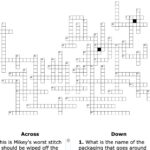This guide decodes DRYSALT, the frequent solution to the “Curing Technique” clue in the New York Times Crossword, especially around November 17-19, 2023. We’ll explore why this seemingly simple word can stump solvers, delve into the science behind it, and examine its broader culinary context.
Why DRYSALT Shows Up in the NYT Crossword
DRYSALT dominates as the solution to the “Curing Technique” clue, baffling some solvers with its specific culinary reference. Let’s unpack why this seven-letter word has earned its place in crossword lore. nytcrosswordanswers.org, crossword-solver.io, and other similar sites probably list DRYSALT as a frequent answer, especially for puzzles appearing around November 18, 2023. This suggests its established presence within the crossword lexicon.
The Challenge of DRYSALT
While “curing” might evoke images of smoky meats or tangy pickles, DRYSALT signifies a specific method. It’s the difference between saying “cooking” and specifying “sous vide” – both involve heat, but one is precise. Similarly, while various curing methods exist, DRYSALT pinpoints the technique of using only salt, no liquid. This nuance is key to conquering culinary crossword clues.
From Crossword to Kitchen: Understanding DRYSALT
Beyond the crossword, DRYSALT represents a surprisingly ancient preservation method. It harnesses salt’s power to extract moisture from food, creating a micro-desert hostile to spoilage-causing microbes. Sailors on long voyages likely relied on dry-salted cod for sustenance, showcasing the historical significance of this technique.
The Science of Osmosis
The magic of DRYSALT hinges on osmosis – water’s tendency to equalize concentration across membranes. Salt creates a low-water environment outside the food, drawing moisture outwards and dehydrating it. This inhibits microbial growth, extending shelf life and intensifying flavors.
Factors Influencing Dry Salting
Several elements affect dry salting’s effectiveness: the salt type, the food’s size and thickness, the environment’s temperature and humidity, and the curing duration. Coarser salts (kosher, sea salt) may be preferred for their slow dissolving and even distribution. Ongoing research explores optimal conditions for various foods, suggesting our understanding of the process continues to evolve.
DRYSALT vs. Other Preservation Methods
DRYSALT stands apart from other preservation techniques:
| Method | Description | Pros | Cons |
|---|---|---|---|
| Dry Salting | Using salt to draw out moisture and preserve food. | Intense flavor, firm texture, long shelf life. | Can be time-consuming, requires precise salt levels. |
| Brining | Submerging food in a salt solution. | Adds moisture, enhances flavor, even salt distribution. | Less intense flavor than dry salting, shorter shelf life. |
| Smoking | Exposing food to smoke for flavor and preservation. | Unique smoky flavor, preservation, can be combined with other methods. | Requires specialized equipment, can be carcinogenic if not done properly. |
| Pickling | Preserving food in an acidic solution. | Tangy flavor, crisp texture, relatively quick process. | Not suitable for all foods, can be high in sodium. |
| Fermenting | Using microorganisms for preservation and flavor development | Probiotic benefits, complex flavors | Requires controlled environment, potential for spoilage if not done correctly |
| Canning | Preserving in airtight containers using heat | Long shelf life, convenient | May alter flavor and texture, potential for botulism if not done correctly |
| Freezing | Preserving at low temperatures | Retains nutrients, easy and convenient | Can cause freezer burn, texture can change with thawing |
| Wet Curing (Brining) | Submerging in a salt and water solution | Adds moisture and flavor, tenderizes meat | Can be salty, requires refrigeration |
| Dehydration | Removing moisture via air or heat | Lightweight, long shelf life | Can lose some nutrients, texture can change |
This table clarifies dry salting’s unique characteristics compared to other methods like brining, smoking, and pickling.
DRYSALT in Action: Culinary Applications
DRYSALT isn’t confined to crosswords; it crafts delicacies like prosciutto and salt cod. Feeling adventurous? Try making gravlax (salt-cured salmon). Check out a comprehensive guide on creating the most extravagant Starbucks drink, the costliest Starbucks drink if you are into trendy drinks.
The Art and Science of Dry Curing
While scientifically straightforward, dry salting also involves artistry. Balancing salt, moisture, and time requires expertise. Cultures worldwide have unique dry-curing traditions, shaping culinary heritage from Italian prosciutto to Portuguese salt cod.
Why DRYSALT Was the NYT Crossword Answer (November 18, 2023)
DRYSALT’s appearance in the November 18, 2023, NYT Crossword as the “Curing Technique” clue is more than coincidence. It reflects the technique’s importance in culinary history. Online solvers like answers.gg and answers.org confirm this. The seven-letter answer neatly fits crossword grids and represents a specific, albeit less common, culinary term. This can pose a challenge for solvers unfamiliar with food preservation techniques, while rewarding those with culinary knowledge.
While DRYSALT is a prevalent answer, the NYT Crossword utilizes other related clues like “Preservation Method”, “Food Treatment” and sometimes “Brining Technique” and hence includes other answers as well. Some theories suggest that the inclusion of culinary-themed clues adds variety and targets a specific demographic of solvers interested in food and cooking, enhancing reader engagement. Others believe it encourages players to expand their knowledge and engage in new interests.
The fact that DRYSALT frequently appears around mid-November could be purely coincidental, or it may reflect a particular theme or pattern in the crossword puzzle’s construction. Further analysis of NYT crosswords during this timeframe might reveal recurring culinary themes or a focus on food preservation techniques, which would add more weight and context to this theory.
The appearance of DRYSALT in the NYT Crossword puzzle acts as a bridge between the puzzle world and the culinary arts. It challenges solvers to look beyond the grid and consider the broader context of words and their meanings. This exploration enriches the solving experience and provides a deeper understanding of the fascinating world of food preservation.
Conclusion
The next time you see “Curing Technique” in a crossword, you’ll appreciate the rich history and science of DRYSALT. It’s a testament to human ingenuity, blending tradition and science to preserve and enhance food. For those interested in anatomy, you might also find the intricacies of the conoid tubercle fascinating.
- Mastering Leader in Spanish: The Complete Guide - April 19, 2025
- Uncovering Surprising Parallels: England Size Compared to US States - April 19, 2025
- Old Mexico Map: Border Shifts 1821-1857 - April 19, 2025
















